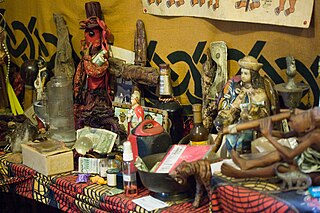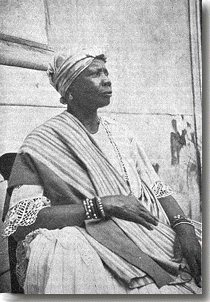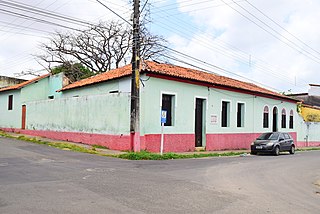
Vodún or vodúnsínsen is an African traditional religion practiced by the Aja, Ewe, and Fon peoples of Benin, Togo, Ghana, and Nigeria. Practitioners are commonly called vodúnsɛntó or Vodúnisants.

Ogun or Ogoun is a Yoruba Orisha that is adopted in several African religions. Ògún is a warrior and a powerful spirit of metal work, as well as of rum and rum-making. He is also known as the "god of iron" and is present in Yoruba religion, Santería, Haitian Vodou, West African Vodun, and the folk religion of the Gbe people. He attempted to seize the throne after the demise of Ọbàtálá, who reigned twice, before and after Oduduwa, but was ousted by Obalufon Ogbogbodirin and sent on an exile – an event that serves as the core of the Ọlọ́jọ́ Festival.

Candomblé is an African diasporic religion that developed in Brazil during the 19th century. It arose through a process of syncretism between several of the traditional religions of West Africa, especially those of the Yoruba and Gbe, and Central Africa Bantu, coupled with influences from Roman Catholicism. There is no central authority in control of Candomblé, which is organized around autonomous terreiros (houses).

Candomblé Ketu is the largest and most influential branch (nation) of Candomblé, a religion practiced primarily in Brazil. The word Candomblé means "ritual dancing or gather in honor of gods" and Ketu is the name of the Ketu region of Benin. Its liturgical language, known as yorubá or Nagô, is a dialect of Yoruba. Candomblé Ketu developed in the early 19th century and gained great importance to Brazilian heritage in the 20th century.

Candomblé Bantu is one of the major branches (nations) of the Candomblé religious belief system. It developed in the Portuguese Empire among Kongo and Mbundu slaves who spoke Kikongo and Kimbundu languages. The supreme and creative god is Nzambi or Nzambi a Mpungu. Below him are the Jinkisi or Minkisi, deities of Bantu mythology. These deities resemble Olorun and the other orishas of the Yoruba religion. Minkisi is a Kongo language term: it is the plural of Nkisi, meaning "receptacle". Akixi comes from the Kimbundu language term Mukixi.

African diaspora religions, also described as Afro-American religions, are a number of related beliefs that developed in the Americas in various areas of the Caribbean, Latin America, and the Southern United States. They derive from traditional African religions with some influence from other religious traditions, notably Christianity and Islam.
Cowrie-shell divination refers to several distinct forms of divination using cowrie shells that are part of the rituals and religious beliefs of certain religions. Though best-documented in West Africa as well as in Afro-American religions, such as Regla de Ocha, Candomblé, and Umbanda, cowrie-shell divination has also been recorded in India, East Africa, and other regions.
Macumba is a generic term for various Afro-Brazilian religions, the practitioners of which are then called macumbeiros. These terms are generally regarded as having negative connotations, comparable to an English term like "black magic". In a broader sense, the term Macumba is used for most Afro-Brazilian religious traditions, including Candomblé and Umbanda. In a more limited sense, macumba is used only to characterize traditions like Quimbanda that revolve around the lesser exu spirits, especially as they are practiced in Rio de Janeiro. Some practitioners of Afro-Brazilian traditions call themselves macumbeiros, although in some instances this is done predominantly in jest.

Nana Buluku, also known as Nana Buruku, Nana Buku or Nanan-bouclou, is the female supreme being in the West African traditional religion of the Fon people and the Ewe people (Togo). She is one of the most influential deities in West African theology, and one shared by many ethnic groups other than the Fon people, albeit with variations. For example, she is called the Nana Bukuu among the Yoruba people and the Olisabuluwa among Igbo people but described differently, with some actively worshiping her while some do not worship her and worship the gods originating from her.
The Mahi are a people of Benin. They live north of Abomey, from the Togo border on the west to the Zou River on the east, and south to Cové between the Zou and Ouemé rivers, north of the Dassa hills.

Olga de Alaketu or Mother Olga was a prominent Candomblé high priestess, who was influential in promoting the African diasporic religion Candomblé and distancing it from Catholicism.
Ile Maroia Laji is one of the oldest Candomblé temples in Salvador, Brazil, in the neighborhood of Matatu de Brotas. It was designated a National Heritage Site in 2005. The temple was influential in the promotion of Candomblé and in distancing the religion from Catholicism under the leadership of High Priestess Olga de Alaketu in the late 20th and early 21st centuries.
Witchcraft in Latin America, known in Spanish as brujería and in Portuguese as bruxaria, is blend of Indigenous, African, and European beliefs. Indigenous cultures had spiritual practices centered around nature and healing, while the arrival of Africans brought syncretic religions like Santería and Candomblé. European witchcraft beliefs merged with local traditions during colonization. Practices vary across countries, with accusations historically intertwined with social dynamics. A male practitioner is called a brujo, a female practitioner is a bruja.

Tambor de Mina is an Afro-Brazilian religious tradition, practiced mainly in the Brazilian states of Maranhão, Piauí, Pará and the Amazon rainforest.

Ṣọ̀pọ̀na is the god of smallpox in the Yoruba religion. The Yoruba people took their traditions about Shapona to the New World when they were transported in the slave trade. He has become known as Babalú-Ayé, among many other names, in the Orisha religion that developed in the Americas.

Eugênia Anna Santos was a Brazilian Iyalorixá. She founded the candomblé Ilê Axé Opó Afonjá in Salvador, now considered a National Historic Landmark, and in Rio de Janeiro.
Zoogodô Bogum Malê Rundó, also known as the Terreiro do Bogum, is a Candomblé terreiro in Salvador, Bahia, Brazil. It is located high in the Engenho Velho da Federação, or simply Federação neighborhood of Salvador on Ladeira do Bogum, a narrow street, formerly known as Ladeira Manoel do Bonfim. It is an area long associated with residents of Kingdom of Dahomey descent. The terreiro covers 1,000 square metres (11,000 sq ft), of which 600 square metres (6,500 sq ft) is used for and includes religious structures and open spaces.

Zogbodo Male Bogun Seja Unde, also known as Terreiro Roça do Ventura, is a Candomblé terreiro (temple) in Cachoeira, Bahia, Brazil. It was founded in 1858, and is the first terreiro founded by Africans of Jeje (Ewe) origin. It is located in the Cabula neighborhood on Rua de São Gonçalo do Retiro, a winding rural road associated with numerous Candomblé terreiros. It is led by Alaíde Augusta da Conceição, also known as Alaíde de Oyá. Zogbodo Male Bogun Seja Unde received heritage status from the Brazilian National Historic and Artistic Heritage Institute (IPHAN) in 2014, and is the first listed terreiro of the Jeje tradition.

The Casa das Minas, or Querebentã Toi Zomadonu, is a-19th century Afro-Brazilian temple in São Luís, Maranhão, Brazil. It is located on Rua de São Pantaleão in the Historic Center of the city. It belongs to the Tambor de Mina, an Afro-Brazilian religion in Maranhão and the Amazon. The Tambor de Mina was established in São Luís in the 1840s by Maria Jesuína, a Dahomean (jeje) noblewoman from present-day Benin, as attested by a deed dated 1847.













